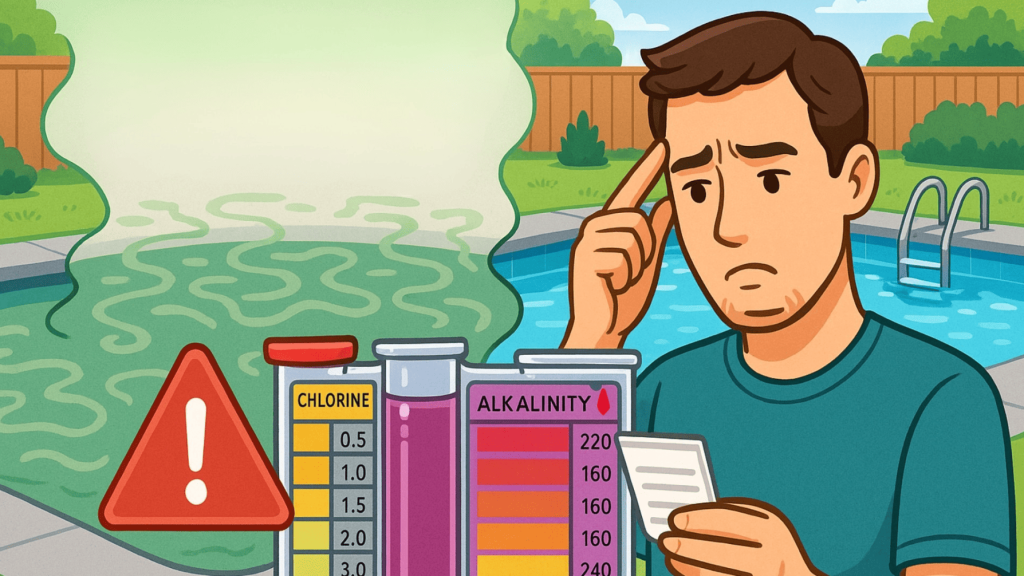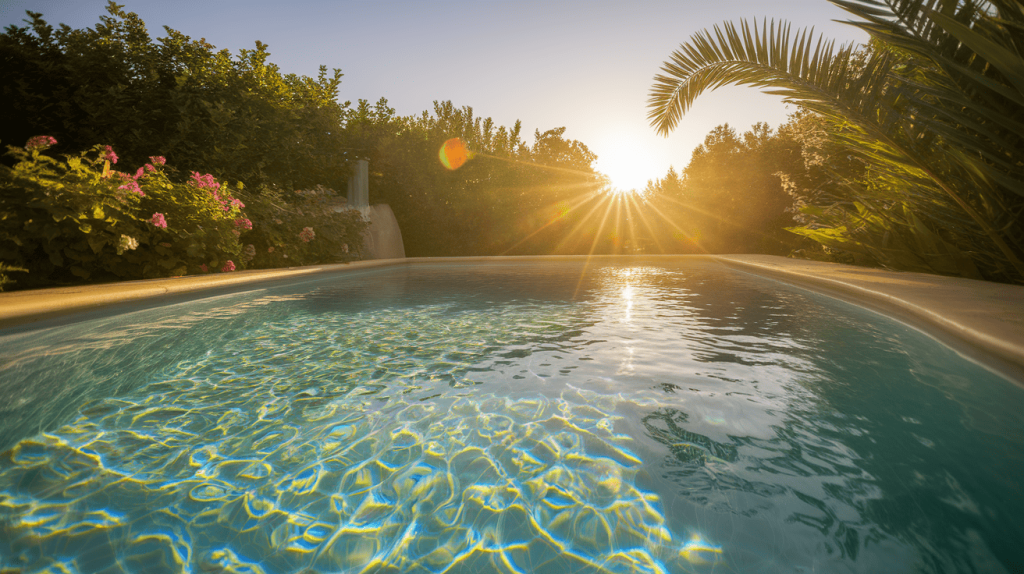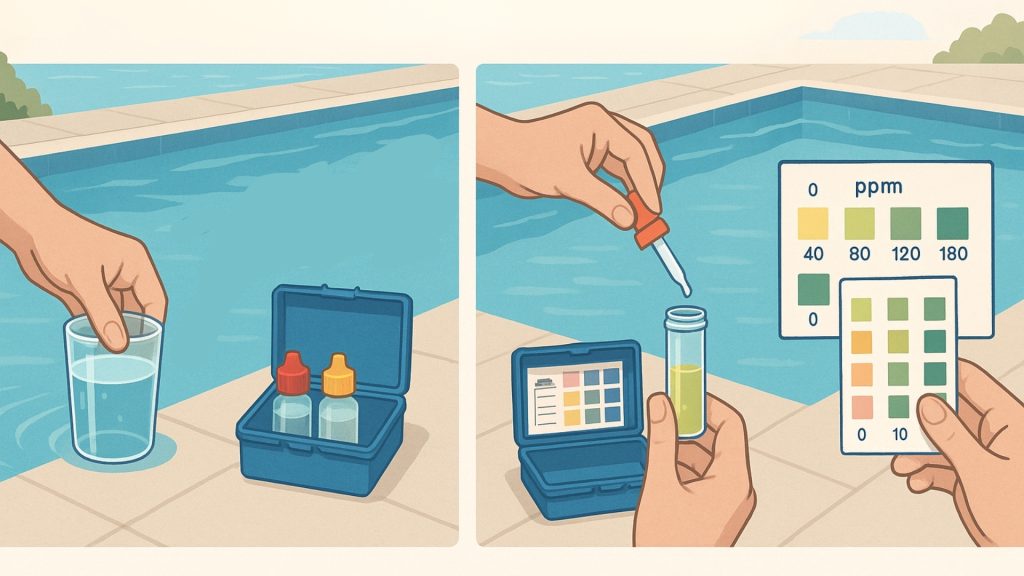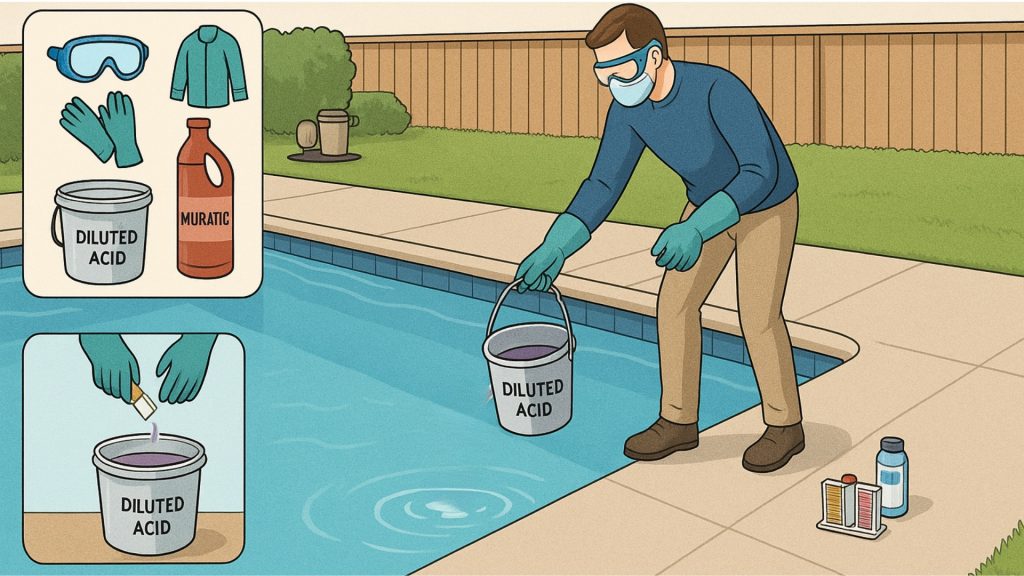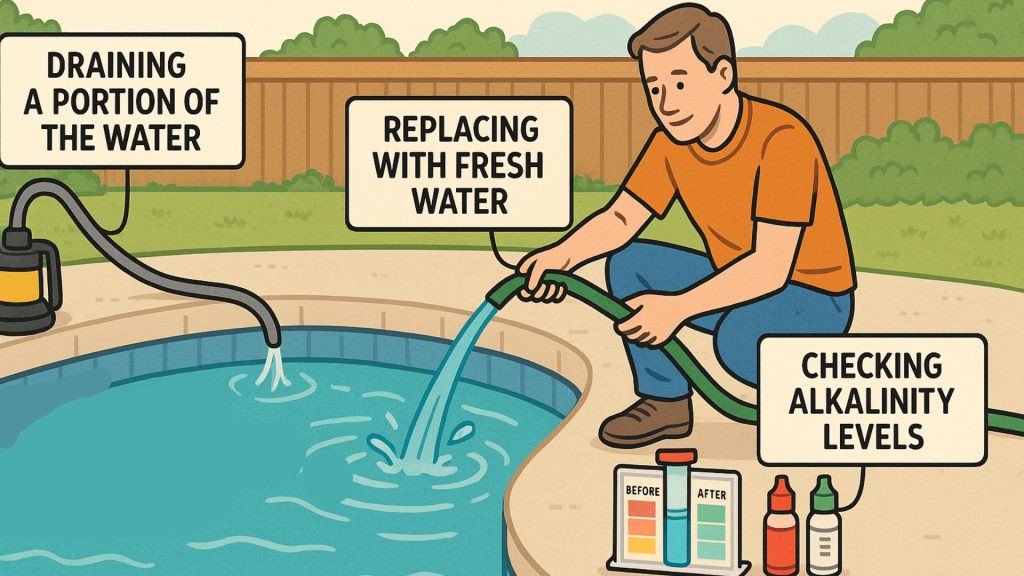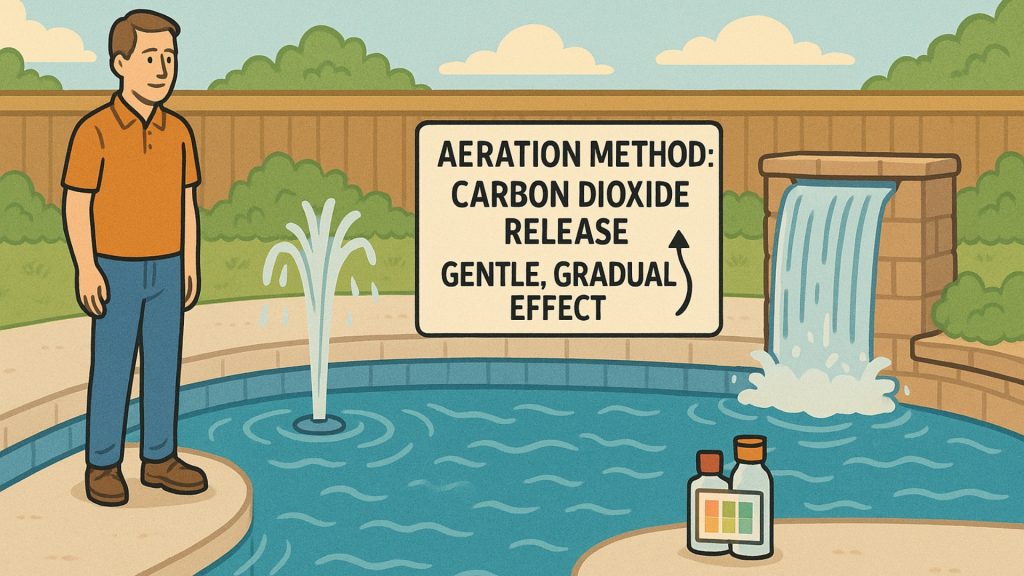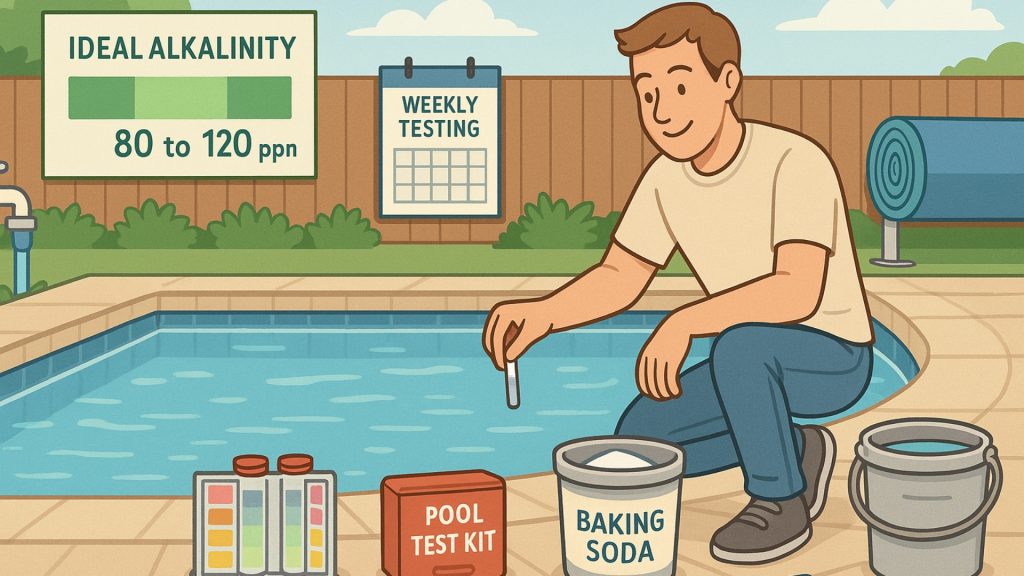Is your pool water cloudy, your pool surfaces rough with scale, or your chemical treatments just not working?
The culprit might be hiding in your water chemistry: high alkalinity.
This invisible imbalance creates visible problems, from equipment damage to swimmer discomfort.
Many pool owners struggle with this common issue without understanding the root cause.
High alkalinity isn’t just a minor annoyance—it’s a chemical imbalance that, if left unchecked, can cost hundreds in repairs and chemicals.
The good news?
Fixing high alkalinity is completely manageable with the right knowledge and tools.
Let’s find out everything you need to know about identifying, fixing, and preventing high pool alkalinity so you can enjoy crystal-clear water again.
What is Pool Alkalinity?
Pool alkalinity refers to the water’s ability to resist changes in pH levels – it’s like a buffer that keeps your pool’s chemistry stable.
While pH measures how acidic or basic your water is on a scale from 0 to 14, alkalinity measures the amount of certain minerals in your water that help maintain that pH balance.
Think of alkalinity as the pH’s bodyguard, preventing it from fluctuating with every new substance that enters your pool.
The ideal alkalinity range for most swimming pools is between 80 and 120 parts per million (ppm).
When your alkalinity is within this sweet spot, your water stays balanced, your pool equipment lasts longer, and swimmers enjoy comfortable water.
However, when alkalinity climbs too high, it can cause a cascade of problems that affect both your pool’s appearance and function.
Why is Pool Alkalinity Important?
Proper pool alkalinity acts as your water’s stabilizing force, keeping pH levels from swinging wildly and causing problems.
When alkalinity is balanced, it protects your expensive pool equipment from corrosion and scaling, potentially saving you thousands in repairs.
High alkalinity can significantly reduce the effectiveness of chlorine and other chemicals you add, meaning you’ll spend more money trying to keep your water safe and clean.
Unbalanced alkalinity affects swimmer comfort, causing eye and skin irritation, uninviting cloudy water, and promoting algae growth.
The chemical balance of your pool water is interconnected, and alkalinity sits at the center of this delicate system.
By maintaining proper alkalinity levels, you’re ensuring your pool remains crystal clear, comfortable to swim in, and less expensive to maintain over time.
What Happens When Pool Alkalinity is Too High?
When pool alkalinity rises above the ideal 120 ppm range, several problems will affect your pool and swimming experience.
These issues can damage equipment and increase maintenance costs if not addressed promptly:
| SYMPTOM | DESCRIPTION | IMPACT |
|---|---|---|
| Cloudy Water | Water becomes hazy | Poor visibility, unappealing appearance |
| Scale Buildup | White/gray deposits form | Damaged surfaces, clogged equipment |
| Chlorine Issues | Sanitizer effectiveness drops | Higher chemical costs, poor sanitization |
| Calcium Scale | Hard mineral deposits appear | Equipment damage, reduced water flow |
| Swimmer Discomfort | Water feels harsh | Eye/skin irritation, unpleasant swimming |
Left untreated, high alkalinity creates an expensive cascade of problems that become increasingly difficult to correct.
Addressing it quickly saves time, money, and frustration.
Causes of High Pool Alkalinity
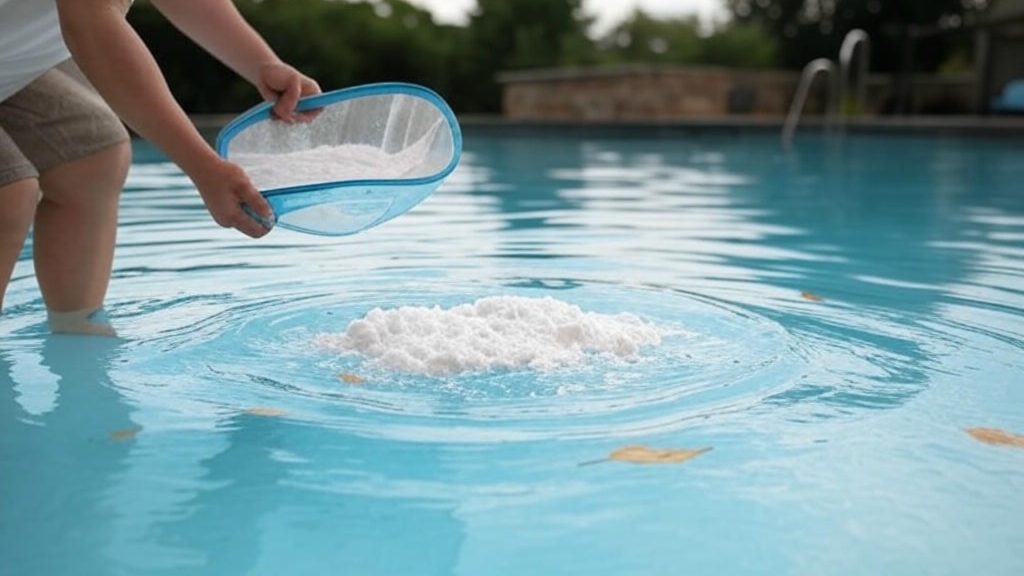
Understanding why your pool’s alkalinity rises helps prevent future problems.
High alkalinity doesn’t usually happen overnight—it typically results from maintenance habits or water sources that gradually introduce alkaline substances into your pool:
- Too much baking soda was added when adjusting water chemistry.
- Using alkaline-heavy pool cleaners or treatments.
- Filling or topping off the pool with hard water from wells or municipal sources.
- Water evaporation concentrates existing minerals and raises alkalinity.
- Lack of regular water testing allows small increases to become major problems.
- Environmental factors, like heavy rain or leaves falling into the pool.
Preventing high alkalinity is much easier than treating it.
By understanding these causes, you can develop better pool maintenance habits and avoid the expensive, time-consuming process of lowering alkalinity once it’s too high.
How to Test Your Pool’s Alkalinity?
Testing your pool’s alkalinity doesn’t need to be complicated.
With the right supplies and a few minutes of your time, you can get an accurate reading that helps you maintain perfect water balance.
Follow these simple steps to test your pool’s alkalinity:
1. Gather Your Testing Supplies
Before testing your alkalinity, make sure you have everything you need.
Most pool owners use either test strips or liquid test kits for convenience.
Test strips are faster but slightly less accurate than liquid kits.
You’ll need clean collection containers that haven’t been exposed to soaps or chemicals.
Please read the instructions that came with your test kit carefully.
Each manufacturer may have slight variations in their testing procedures.
2. Collect Pool Water Sample
The way you collect your water sample matters more than most people realize.
Dip your container about 12-18 inches below the surface, away from any return jets, skimmers, or pool steps.
This “elbow-deep” water gives you the most accurate picture of your pool’s chemistry.
Avoid skimming the surface water or collecting near recently added chemicals.
The sample should represent the average water condition throughout your entire pool.
3. Test the Water
With test strips, you’ll dip the strip into your collected water sample, hold it there for the recommended time (usually just a few seconds), and then remove it.
With liquid test kits, you’ll add specific reagent drops to a small water sample in a test tube.
Both methods require you to wait a short time for the colors to develop fully.
Be patient and follow timing instructions exactly—rushing this step leads to inaccurate readings.
4. Compare the Results
After waiting the recommended time, hold your test strip against the color chart in good natural lighting (avoid direct sunlight).
Find the color that most closely matches your test strip’s color pad for alkalinity.
With liquid kits, compare the test water color to the provided chart or use the included color comparator.
The number corresponding to your matching color is your alkalinity reading in parts per million (ppm).
Remember that 80-120 ppm is ideal for most pools.
5. Interpret and Adjust (if needed)
Once you have your reading, you’ll know if action is required.
If your alkalinity is within the 80-120 ppm range, you’re perfect—no adjustments are needed.
Test weekly during swimming season, after heavy rain, or when adding fresh water to maintain consistent chemistry.
Regular testing prevents minor issues from escalating into major problems.
How to Fix High Pool Alkalinity?
When your test reveals alkalinity levels above 120 ppm, it’s time to take action.
Fixing high alkalinity requires patience and careful application of the right methods.
Remember that it’s always better to make several small adjustments over time rather than one dramatic change that could throw other aspects of your water chemistry out of balance.
1. Add Acid to Lower Alkalinity
The most common method of reducing alkalinity is adding acid to pool water.
There are two main options: muriatic acid (hydrochloric acid) or sodium bisulfate (dry acid).
Muriatic acid works faster and is less expensive, but is more dangerous to handle and store.
Sodium bisulfate is safer and easier to use, but it costs more and works more slowly.
Always add acid to water first (never water to acid), wear protective gear, and slowly pour the diluted solution into the pool’s deep end while the pump is running.
Never add more than the recommended amount at once—it’s better to retest and add more later if needed.
2. Dilution with Fresh Water
If your alkalinity is only slightly high (between 120-150 ppm) and you’re due for some water replacement anyway, the dilution method can be effective.
This involves draining a portion of your pool water and replacing it with fresh water that has lower alkalinity.
This method works well for small alkalinity adjustments and avoids using harsh chemicals.
While this uses more water, it’s very gentle on your pool system and won’t cause pH fluctuations.
This approach is ideal if your source water has low alkalinity and you only need a moderate reduction in your levels.
3. Aeration Technique
Aeration is a natural method that releases carbon dioxide from pool water, helping lower alkalinity over time.
You can increase aeration by running water features, fountains, waterfalls, or pointing return jets upward to create surface disturbance.
This method is very gentle but also very slow, expect to see results in days rather than hours.
The major advantage is that, unlike acid treatments, it won’t significantly impact your pH levels.
Aeration works best when combined with other methods or when you have time to wait for gradual improvement.
It’s perfect for maintaining long-term balance rather than quick fixes.
Preventing High Alkalinity in the Future
Maintaining proper alkalinity is easier than correcting problems that arise.
A small investment of time in regular monitoring can prevent expensive fixes and pool downtime.
Here’s how to keep your pool’s chemistry balanced:
- Test water weekly during swim season and monthly in off-season
- Use alkaline chemicals (baking soda, soda ash) sparingly and precisely
- If you have hard water, consider filtered water for top-offs
- Cover your pool to reduce evaporation that concentrates minerals
- Make small, gradual chemical adjustments instead of large doses
- Schedule professional service annually for thorough testing
Consistent prevention saves time and money, ensuring your pool stays crystal clear and swimmer-friendly throughout the entire season.
Your future self will thank you for the effort, as you’ll spend more time enjoying your pool and less time fixing chemical imbalances.
Summing It Up
High pool alkalinity doesn’t have to ruin your swimming season.
Armed with the right knowledge, testing tools, and treatment methods, you can confidently tackle this common water chemistry issue.
Remember that maintaining balanced alkalinity is an ongoing process, not a one-time fix.
Regular testing, careful chemical additions, and aggressive maintenance will keep your water crystal clear and your pool equipment protected.
Your reward? A gentle sparkling pool for swimmers, efficient sanitizing saves on chemicals, and longer-lasting equipment.
Take control of your pool’s alkalinity today and enjoy worry-free swimming all season long.

